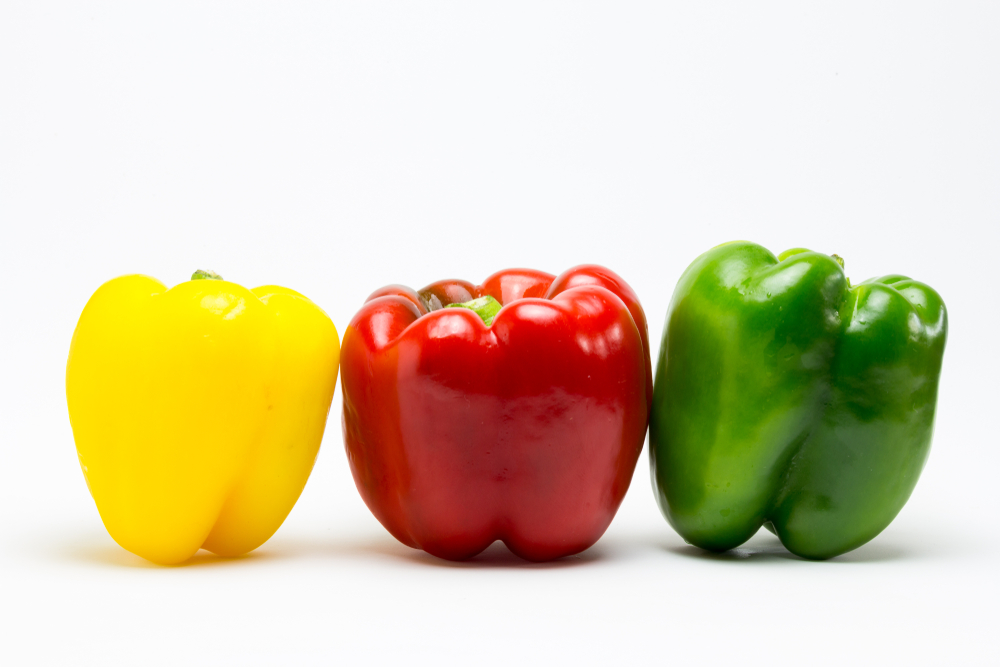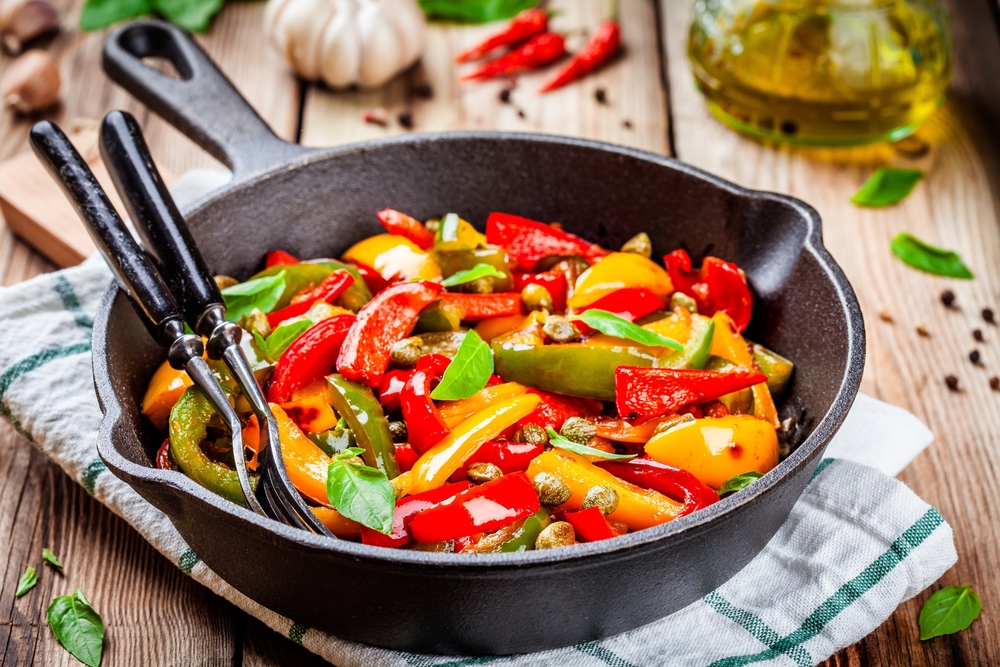Peperonata is a classic Italian dish from the Calabria region in Southern Italy. This rustic stew combines bell peppers, garlic, onion, and tomatoes to form a simple and delicious dish often served with crusty Italian bread.
What Is Peperonata?
Peperonata is a prepared vegetable stew of peppers, onion, garlic, and tomatoes that goes great with just about any meal. It usually has a beautiful array of colors from tomatoes and whatever colors of pepper you use.
The overall flavor of peperonata is highly focused on the bright, sweet pepper flavor, balanced by the acidity of the tomatoes and the richness of the olive oil. It’s a delicious and well-balanced dish that can be prepared in just 30 minutes. You can cook the dish to your desired doneness, leaving the peppers with a bit of crunch and texture, or stewing them longer for a soft, thick, spreadable dish.

What Are The Ingredients In Peperonata?
Let’s briefly break down each ingredient that goes into peperonata.
Bell Peppers
Bell peppers are the most vital ingredient in the dish. Not all peppers will provide you with a tender and sweet peperonata, so choosing the juiciest and sweetest bell peppers is essential.
I recommend using orange, yellow, and red bell peppers, which are the sweetest. If you like the taste of green peppers, they will be fine in this dish, but they do have a bitterness that can combat the sweetness from the tomatoes and sweeter bell peppers.
Olive Oil
While you can theoretically prepare peperonata with vegetable or coconut oil, DON’T; the flavor of your peperonata is highly dependent on the earthy and rich notes from olive oil. I recommend using extra virgin olive oil for the best taste and quality. I buy the Partanna brand from my local Italian grocery store, but most grocery stores carry affordable, quality olive oil.
Garlic
Many Italian dishes rely on garlic for its intense, potent flavor, and peperonata retains this pattern. You’ll want to find a bulb with large cloves, as you’ll be slicing it finely into the dish. Larger garlic cloves are also milder than small ones.
Onion
I almost always use yellow onions when preparing Italian meals. You can also use red onions or shallots if you want the dish to be spicier or milder.
Diced Tomatoes
Since the tomatoes are cooked down into a stew, I highly recommend roma tomatoes. They are my go-to for making a basic tomato sauce, and they just so happen to be fantastic in peporanata. While romas are perfect for this dish, use any variety of plum tomatoes that you prefer.
While peperonata doesn’t need a thick tomato sauce base, you can always add small amounts of tomato paste or purée. This will add more moisture and acidity for a more dense and spreadable peperonata.
Basil
I like to add finely-chopped, fresh basil leaves to my peperonata at the end of the cooking process as you pull the pan off the heat.
Seasoning
Keep it simple: add a small amount of salt and freshly ground black pepper. This dish focuses on all the fresh vegetables and how their flavors intermingle, so I don’t often add many other classic Italian seasonings like fennel or oregano.
Sugar
When it comes to cooking, one of the most important things I’ve learned from my Sicilian mother is always to add a small amount of sugar when cooking with tomatoes. Sugar will cut through the acidic and bitter qualities of the tomatoes and peppers in peperonata, leading to a sweeter and more well-rounded dish.
Is Peperonata Spicy Or Sweet?
Peperonata is all about the sweetness of the peppers and usually has very little heat, unless you decide to add other peppers. Bell peppers have 0 SHU on the Scoville scale, meaning they have no spiciness.
If you are looking for a little spicy kick, you can add a couple of hot peppers to your recipe. I recommend using Calabrian chili peppers, as they are also Italian and will give the dish an authentic Mediterranean flavor. Be warned, though, Calabrains are 25,000-40,000 SHUs, meaning a little will go a long way! Another great way to add a little heat is to sprinkle in a small number of red pepper flakes as the peperonata cooks down.
What Do You Serve Peperonata With?
Growing up in an Italian family, I’ve had my fair share of peperonata, and it truly is fantastic with so many different meals! Peporanata is an excellent topping for grilled Italian sausages, perfect when served on top of fresh pasta, and fabulous with just a thick slice of crusty Italian bread.
Whether served as a side dish for polenta or as an appetizer with bruschetta, peperonata is one of the best Italian pepper recipes to add to your Italian dinner night. Some people enjoy adding vegetables to their peperonata, such as zucchini, capers, and potatoes, for additional texture and flavor.
What Color Bell Peppers Are In Peperonata?
As I previously mentioned, I recommend using yellow, red, or orange bell peppers as they will have the brightest and sweetest flavor for peperonata.
Green bell peppers aren’t very sweet, which means they will only add bitterness to your dish.

How To Fix Bitter Peperonata
While adding green peppers to your peperonata will undoubtedly add unwanted bitterness, it isn’t the only culprit for having bitter peperonata. If your peperonata is still too bitter for your liking and you’ve tried using only the sweetest bell peppers, then it is more than likely that your peperonata needs sugar.
Sugar can be an undervalued ingredient when it comes to cooking savory dishes. Especially when you’re cooking with vegetables that can have vegetal and earthy bitter flavors, adding a small amount of sugar is sometimes all it takes to balance the dish perfectly.
Should You Peel Bell Peppers For Peperonata?
While I recommend leaving the skin on for better texture and visual presentation, some people don’t like the consistency of cooked pepper skins. If this is the case, then I recommend the simple process of blanching peppers to remove the skin easily.
Bring a pot of water to a boil, add a pinch of salt, and toss your peppers for 2-3 minutes. Then, immediately remove the peppers and place them in an ice bath to prevent them from overcooking.
At this point, the peppers will have cooked just long enough for the skin to loosen from the flesh of the pepper without making the peppers mushy. You should be able to peel away the skin easily, and your peppers will be ready to go for peperonata!
How To Make Peperonata
One of the best parts of peperonata is how quick and easy it is to make. Because each vegetable is added to the pan at different times, you can even prep some of the ingredients as you go!
Print
Peperonata
- Total Time: 30 minutes
Description
Try this delicious and simple recipe for authentic Italian stewed peppers and onions.
Ingredients
- 6 bell peppers (orange, red, or yellow)
- 4 large garlic cloves, thinly slices
- 1/4 cup extra virgin olive oil
- 1 tbsp sugar
- 1/3 fresh basil, torn or roughly chopped
- 1 large onion, sliced
- 5 roma tomatoes, roughly chopped
- salt and pepper to taste
Instructions
- Heat a large pot or dutch oven with olive oil over the stovetop over medium-low heat.
- Add onions to the pot first and cook for 3-4 minutes.
- Add peppers, tomatoes, salt, pepper, and sugar to the pot and cook over medium-low for about 20 minutes. Stir occasionally
- Take the pot off of the heat and stir in your chopped basil.
- Prep Time: 10 minutes
- Cook Time: 20 minutes
- Category: Side Dish
- Cuisine: Italian

